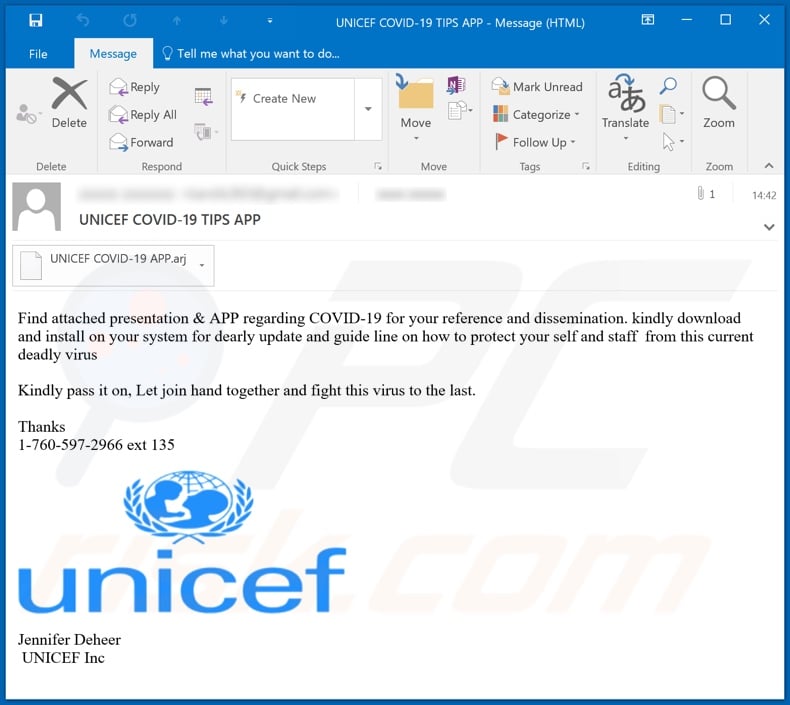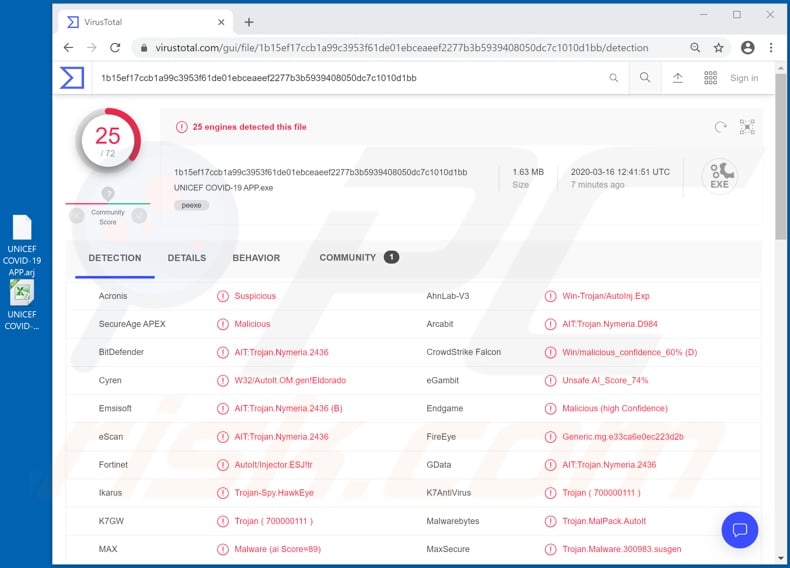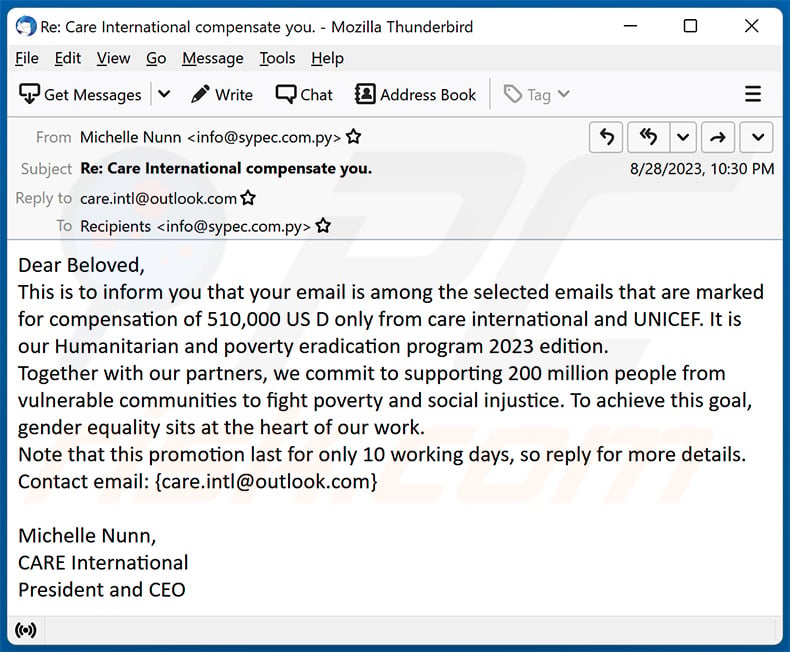Avoid installing malware spread via the "UNICEF COVID-19 TIPS APP" email
Phishing/ScamAlso Known As: UNICEF spam
Get free scan and check if your device is infected.
Remove it nowTo use full-featured product, you have to purchase a license for Combo Cleaner. Seven days free trial available. Combo Cleaner is owned and operated by RCS LT, the parent company of PCRisk.com.
What is the "UNICEF" email virus?
"UNICEF" is a deceptive email (subject: "UNICEF COVID-19 TIPS APP") designed to spread the Netwire Remote Access Trojan (RAT). This scam message abuses the current social climate (at time of writing, the coranavirus pandemic) to trick recipients into opening its malicious attachment.
The attached file supposedly contains a presentation and Advanced Practice Provider tips, however, installing this file will infect the system with the Netwire RAT.

The text presented in the "UNICEF COVID-19 TIPS APP" email states that it has attached a file, which is the presentation and APP concerning the Corona virus. In this context, the abbreviation relates to two different terms and serves two purposes.
In healthcare terms, "APP" is "Advanced Practice Provider", which is inline with the aim of the scam, especially since the infectious attachment is disguised as an Excel document (which is within the archived file).
The statement in the message encourages users to download and install an attached file, and hence the APP abbreviation can be interpreted (or misinterpreted) as "Application". This interpretation is furthered, as it is claims that the "APP" is updated daily (though the last word is misspelled and the message also contains other errors).
Therefore, the scam's chances of success are potentially increased by users who are influenced by the message. The email states that the information will aid recipients to protect themselves and their staff respectively. It also requests that users share the email - in this way, they will unintentionally spread the Netwire Trojan.
This malware is designed to give the cyber criminals behind the "UNICEF" scam email remote access and control over devices. Keylogging is a particularly dangerous capability of Netwire - it can record all information typed by individuals using the infected device.
Therefore, it can steal the credentials (log-ins and passwords) of emails, social media and social networking, communication, e-commerce, banking and countless other accounts. To summarize, the Netwire RAT can cause financial loss, severe privacy issues and identity theft.
Do not trust the "UNICEF" email scam. If you suspect that Netwire (or other malware) is already present on the system, use anti-virus software to remove it immediately.
| Name | UNICEF spam |
| Threat Type | Trojan, password-stealing virus, banking malware, spyware. |
| Hoax | Emails claims to be from UNICEF, containing important information concerning the coronavirus. |
| Attachment(s) | UNICEF COVID-19 APP.arj containing UNICEF COVID-19 APP.exe |
| Detection Names | Avast (Script:SNH-gen [Trj]), BitDefender (AIT:Trojan.Nymeria.2436), Emsisoft (AIT:Trojan.Nymeria.2436 (B)), Kaspersky (UDS:DangerousObject.Multi.Generic), Full List Of Detections (VirusTotal) |
| Symptoms | Trojans are designed to stealthily infiltrate the victim's computer and remain silent, and thus no particular symptoms are clearly visible on an infected machine. |
| Payload | Netwire RAT |
| Distribution methods | Infected email attachments, malicious online advertisements, social engineering, software 'cracks'. |
| Damage | Stolen passwords and banking information, identity theft, the victim's computer added to a botnet. |
| Malware Removal (Windows) |
To eliminate possible malware infections, scan your computer with legitimate antivirus software. Our security researchers recommend using Combo Cleaner. Download Combo CleanerTo use full-featured product, you have to purchase a license for Combo Cleaner. 7 days free trial available. Combo Cleaner is owned and operated by RCS LT, the parent company of PCRisk.com. |
Deceptive/scam emails are sent by the thousand during operations called "spam campaigns". This mail is usually disguised as "official", "important", "priority" and similar. It can even incorporate the names of legitimate organizations, companies, services and similar (e.g. UNICEF).
The purpose of these message is to generate revenue for the individuals behind them. This can be done through proliferation of malware (e.g. trojans, ransomware, cryptominers and so on), however, they can carry out their purpose using other techniques.
For example, these emails can attempt to steal recipients' personal information via phishing websites, or trick them into making monetary transactions (e.g. fake shipping, subscription, registration fees and other fraudulent payments), and the use of many other tactics.
"COVID-19 Insurance Plan From CIGNA", "WeTransfer", "Adobe Document Cloud E-Signing", and "Secret Love" are some examples of other email scams designed to proliferate malicious software.
How did "UNICEF email virus" infect my computer?
Infections originate from the dangerous files attached to, or linked inside, deceptive/scam emails. These files can be in various formats such as archive (ZIP, RAR, ARJ, etc.) and executable (.exe, .run, etc.) files, Microsoft Office and PDF documents, JavaScript and others.
When infectious files are executed, run or otherwise opened, the infection process starts (i.e., download/installation of malware). For example, MS Office documents infect systems when macro commands are enabled (i.e., editing is enabled). This process starts automatically when a malicious Microsoft Office document is opened in MS Office versions released prior to 2010.
How to avoid installation of malware
Suspicious or irrelevant emails should not be opened, especially those received from unknown/suspicious senders (addresses). Any attachments or links present in such mail must not be opened, as doing so can result in high-risk infection.
Since malicious Microsoft Office documents opened in Microsoft Office programs released before 2010 immediately start the infection process, it is important to use newer versions (these have "Protected View" mode, which asks users to enable macro commands, and thus malware download/installation is not triggered when the document is opened).
Malicious content also proliferates through untrusted download channels (e.g. unofficial and free file-hosting sites, Peer-to-Peer sharing networks and other third party downloaders), illegal activation tools ("cracks") and fake updaters. Therefore, use official and verified download sources, and activate and update software with tools/functions provided by legitimate developers.
To ensure device/user safety, have a reputable anti-virus/anti-spyware suite installed and kept up to date. Furthermore, use this software for regular system scans and removal of detected/potential threats. If you have already opened "UNICEF email virus" attachment, we recommend running a scan with Combo Cleaner Antivirus for Windows to automatically eliminate infiltrated malware.
Text presented in the "UNICEF email virus" email message:
Subject: UNICEF COVID-19 TIPS APP
Find attached presentation & APP regarding COVID-19 for your reference and dissemination. kindly download and install on your system for dearly update and guide line on how to protect your self and staff from this current deadly virus
Kindly pass it on, Let join hand together and fight this virus to the last.
Thanks
1-760-597-2966 ext 135Jennifer Deheer
UNICEF Inc
Screenshot of the malicious attachment ("UNICEF COVID-19 APP.arj" - this contains "UNICEF COVID-19 APP.exe", which installs Netwire) detection on VirusTotal:

An example of UNICEF-themed phishing email:

Text presented within:
Subject: Re: Care International compensate you.
Dear Beloved,
This is to inform you that your email is among the selected emails that are marked for compensation of 510,000 US D only from care international and UNICEF. It is our Humanitarian and poverty eradication program 2023 edition.
Together with our partners, we commit to supporting 200 million people from vulnerable communities to fight poverty and social injustice. To achieve this goal, gender equality sits at the heart of our work.
Note that this promotion last for only 10 working days, so reply for more details.
Contact email: {care.intl@outlook.com}
Michelle Nunn,
CARE International
President and CEO
Instant automatic malware removal:
Manual threat removal might be a lengthy and complicated process that requires advanced IT skills. Combo Cleaner is a professional automatic malware removal tool that is recommended to get rid of malware. Download it by clicking the button below:
DOWNLOAD Combo CleanerBy downloading any software listed on this website you agree to our Privacy Policy and Terms of Use. To use full-featured product, you have to purchase a license for Combo Cleaner. 7 days free trial available. Combo Cleaner is owned and operated by RCS LT, the parent company of PCRisk.com.
Quick menu:
- What is UNICEF spam?
- Types of malicious emails.
- How to spot a malicious email?
- What to do if you fell for an email scam?
Types of malicious emails:
![]() Phishing Emails
Phishing Emails
Most commonly, cybercriminals use deceptive emails to trick Internet users into giving away their sensitive private information, for example, login information for various online services, email accounts, or online banking information.
Such attacks are called phishing. In a phishing attack, cybercriminals usually send an email message with some popular service logo (for example, Microsoft, DHL, Amazon, Netflix), create urgency (wrong shipping address, expired password, etc.), and place a link which they hope their potential victims will click on.
After clicking the link presented in such email message, victims are redirected to a fake website that looks identical or extremely similar to the original one. Victims are then asked to enter their password, credit card details, or some other information that gets stolen by cybercriminals.
![]() Emails with Malicious Attachments
Emails with Malicious Attachments
Another popular attack vector is email spam with malicious attachments that infect users' computers with malware. Malicious attachments usually carry trojans that are capable of stealing passwords, banking information, and other sensitive information.
In such attacks, cybercriminals' main goal is to trick their potential victims into opening an infected email attachment. To achieve this goal, email messages usually talk about recently received invoices, faxes, or voice messages.
If a potential victim falls for the lure and opens the attachment, their computers get infected, and cybercriminals can collect a lot of sensitive information.
While it's a more complicated method to steal personal information (spam filters and antivirus programs usually detect such attempts), if successful, cybercriminals can get a much wider array of data and can collect information for a long period of time.
![]() Sextortion Emails
Sextortion Emails
This is a type of phishing. In this case, users receive an email claiming that a cybercriminal could access the webcam of the potential victim and has a video recording of one's masturbation.
To get rid of the video, victims are asked to pay a ransom (usually using Bitcoin or another cryptocurrency). Nevertheless, all of these claims are false - users who receive such emails should ignore and delete them.
How to spot a malicious email?
While cyber criminals try to make their lure emails look trustworthy, here are some things that you should look for when trying to spot a phishing email:
- Check the sender's ("from") email address: Hover your mouse over the "from" address and check if it's legitimate. For example, if you received an email from Microsoft, be sure to check if the email address is @microsoft.com and not something suspicious like @m1crosoft.com, @microsfot.com, @account-security-noreply.com, etc.
- Check for generic greetings: If the greeting in the email is "Dear user", "Dear @youremail.com", "Dear valued customer", this should raise suspiciousness. Most commonly, companies call you by your name. Lack of this information could signal a phishing attempt.
- Check the links in the email: Hover your mouse over the link presented in the email, if the link that appears seems suspicious, don't click it. For example, if you received an email from Microsoft and the link in the email shows that it will go to firebasestorage.googleapis.com/v0... you shouldn't trust it. It's best not to click any links in the emails but to visit the company website that sent you the email in the first place.
- Don't blindly trust email attachments: Most commonly, legitimate companies will ask you to log in to their website and to view any documents there; if you received an email with an attachment, it's a good idea to scan it with an antivirus application. Infected email attachments are a common attack vector used by cybercriminals.
To minimise the risk of opening phishing and malicious emails we recommend using Combo Cleaner Antivirus for Windows.
Example of a spam email:

What to do if you fell for an email scam?
- If you clicked on a link in a phishing email and entered your password - be sure to change your password as soon as possible. Usually, cybercriminals collect stolen credentials and then sell them to other groups that use them for malicious purposes. If you change your password in a timely manner, there's a chance that criminals won't have enough time to do any damage.
- If you entered your credit card information - contact your bank as soon as possible and explain the situation. There's a good chance that you will need to cancel your compromised credit card and get a new one.
- If you see any signs of identity theft - you should immediately contact the Federal Trade Commission. This institution will collect information about your situation and create a personal recovery plan.
- If you opened a malicious attachment - your computer is probably infected, you should scan it with a reputable antivirus application. For this purpose, we recommend using Combo Cleaner Antivirus for Windows.
- Help other Internet users - report phishing emails to Anti-Phishing Working Group, FBI’s Internet Crime Complaint Center, National Fraud Information Center and U.S. Department of Justice.
Share:

Tomas Meskauskas
Expert security researcher, professional malware analyst
I am passionate about computer security and technology. I have an experience of over 10 years working in various companies related to computer technical issue solving and Internet security. I have been working as an author and editor for pcrisk.com since 2010. Follow me on Twitter and LinkedIn to stay informed about the latest online security threats.
PCrisk security portal is brought by a company RCS LT.
Joined forces of security researchers help educate computer users about the latest online security threats. More information about the company RCS LT.
Our malware removal guides are free. However, if you want to support us you can send us a donation.
DonatePCrisk security portal is brought by a company RCS LT.
Joined forces of security researchers help educate computer users about the latest online security threats. More information about the company RCS LT.
Our malware removal guides are free. However, if you want to support us you can send us a donation.
Donate
▼ Show Discussion